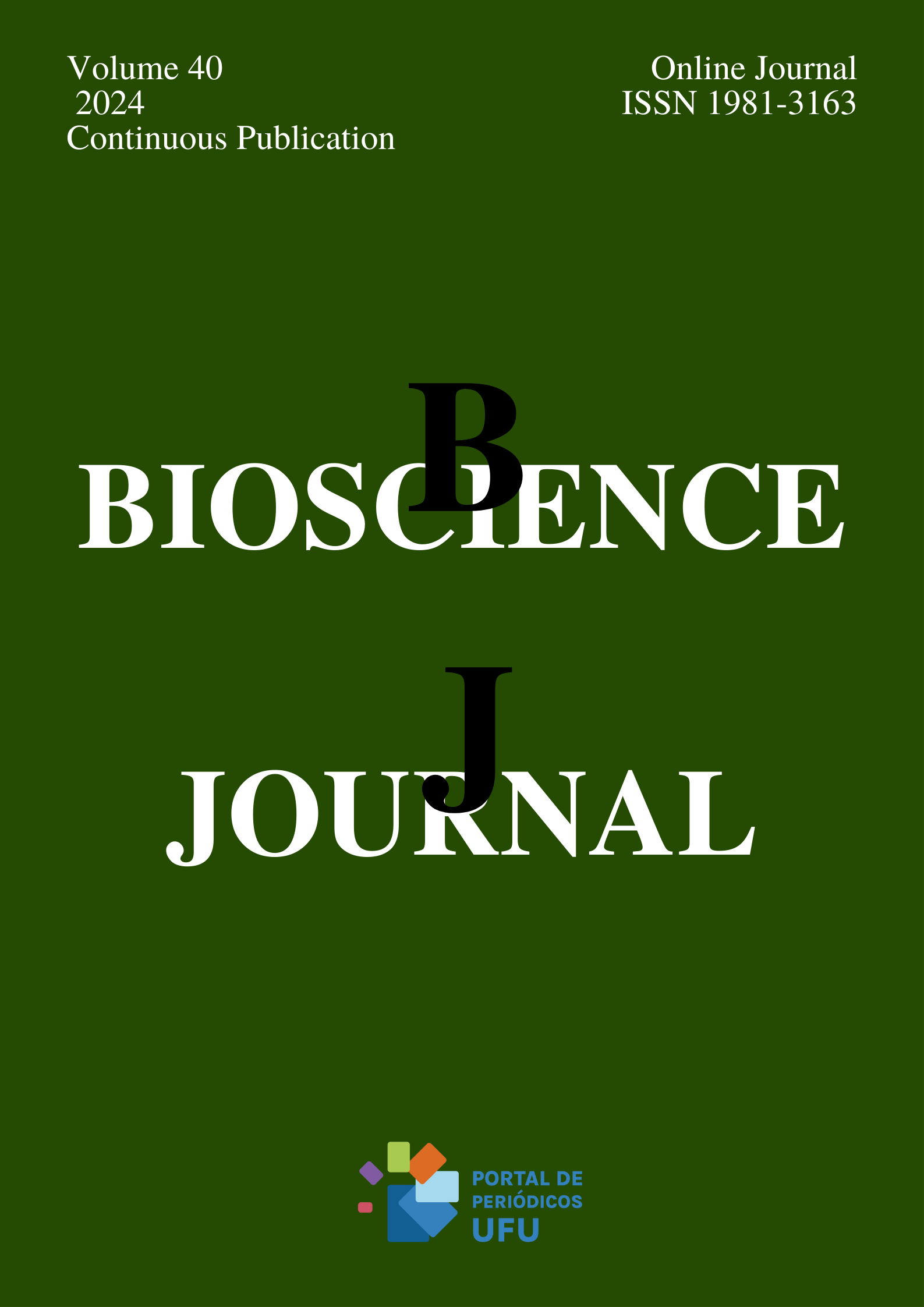Relationship of potassium doses with bioethanol yield in sweet potato in Cerrado soil
DOI:
https://doi.org/10.14393/BJ-v40n0a2024-62933Keywords:
Ethanol, Ipomea Batatas, Starch, Tropical.Abstract
Sweet potato-bioethanol yield was evaluated in response to potassium fertilizer application. Experiments were performed using a 5 × 2 factorial design in which factors included the amount of K2O applied to the soil, with five levels (0, 30, 60, 120, and 240 kg ha-1) and genotype, with two levels (industrial genotype BDGPI #25 and table genotype BDGPM #04). Root yield, root starch and soluble solid contents, bioethanol yield, and economic viability of potassium application for bioethanol production were evaluated. Potassium affected root yield of both genotypes, with the highest yield observed at 140 kg K2O ha-1. Root starch concentration at harvest depended on genotype potential rather than potassium dose. Soluble solid content in fresh roots was lower than that in cooked roots, in which case, maximum conversion efficiency was observed at 109,69 and at 123.75 kg K2O ha-1 for BDGPM#04 and BDGPI#25, respectively. Bioethanol yield reached 10,484 and 9,839 L ha-1 at 151.87 and 136 kg K2O ha-1 for BDGPI#25 and BDGPM#04, respectively. Genotype BDGPI#25 was more efficient than sugarcane in converting potassium to bioethanol at 151.87 kg K2O ha-1, producing 10,484.29 L of bioethanol. In turn, BGDPM#04 showed maximum conversion efficiency relative to sugarcane at 122 kg K2O ha-1.
Downloads
References
CEREDA, M.P., et al. Propriedades gerais do amido. Fundação Cargill, Campinas, 2001.
CLIMA TEMPO. Climatologia e histórico de previsão do tempo em Gurupi - BR. Série de dados de 30 anos observados. Available from: https://www.climatempo.com.br/climatologia/589/gurupi-to
CONAB. Cana-de-Açucar. Acompanhamento de safras – Cana-de-açúcar Safra. 2019.
DIACONU, A., et al. Dinâmica do processo de produção de batata-doce cultivada em condições de solo arenoso da romênia. Pakistan Journal of Botany 2019, 51(2) 617-622.
EMBRAPA. Sistema brasileiro de classificação de solos. 5ª ed. Brasília: Embrapa, 2018.
EPE - Empresa de Pesquisas energéticas. Análise de Conjuntura dos Biocombustíveis. 2019. Available from: https://www.epe.gov.br/sitespt/publicacoesdadosabertos/publicacoes/PublicacoesArquivos/publicacao-402/EPE
EPE - Empresa de Pesquisas energéticas. Balanço Energético Nacional 2020. 2020, Rio de Janeiro - Rj. Available from: https://www.epe.gov.br/sites-pt/publicacoes-dadosabertos/publicacoes/PublicacoesArquivos/publicacao479/topico521/Relato%cc%81rio%20Si%cc%81ntese%20BEN%202020ab%202019_Final.pdf
FAO. Food and Agriculture Organization of the United Nations. Agricultural production: primary crops. Roma. 2021. Available from: http://www.fao.org
FERREIRA, D.F. SISVAR-Sistema de análise de variância. 2018.
FERREIRA, J.C. and DE RESENDE, G. M. Batata-doce: cultivar adequado faz toda a diferença. Embrapa Semiárido-Artigo em periódico indexado (ALICE), 2019.
LÁZARI, T.M., et al. Path analysis in characteristics of sweet potato clones aiming ethanol yield. Brazilian Journal of Applied Technology for Agricultural Science. 2014, 7(2) 41-47. https://doi.org/10.5935/PAET.V7.N2.05
LIMA, L.F., et al. Balanços energético e econômico para produção de etanol a partir de batata-doce. Pesquisa Agropecuária Brasileira. 2019, 54. https://doi.org/10.1590/S1678-3921.pab2019.v54.26521
LOURENÇO, A.M., et al. Potencial de clones experimentais de batata-doce para produção de etanol. Nativa. 2018, 6(4) 352-357. http://dx.doi.org/10.31413/nativa.v6i4.5613
MACHADO, C.M.M. and ABREU, F. R. Álcool combustível a partir da batata. Batata Show, Itapetinga. 2007, 7(18) 34-36.
MOTA, J.H., et al., 2016. Nutrição e adubação da cultura da batata-doce. In: R. de M. PRADO and A.B.C. FILHO, eds. Nutriçao e Adubação de Hortaliças. UNESP – Jaboticabal, pp. 541-558.
NASSER, M.D., et al. Produtividade e qualidade de raízes de batata-doce propagadas por diferentes tamanhos de miniestacas. Scientia Plena. 2020, 16(7). https://doi.org/10.14808/sci.plena.2020.070204
NEUMANN, É.R. et al. Doses de potássio na produção e qualidade do álcool de batata-doce. Revista Brasileira de energias renováveis. 2014, 3(4). DOI: http://dx.doi.org/10.5380/rber.v3i4.38617
OLIVEIRA, A.M.S., et al. Performance of sweet potato clones for bioethanol production in different cultivation periods. Horticultura Brasileira. 2017, 35, 57-62. https://doi.org/10.1590/s0102-053620170109
OLIVEIRA, M.R.B., Et al. Produção de etanol a partir de melaço de cana. Revista de Estudos Ambientais. 2019, 21(1) 38-45. http://dx.doi.org/10.7867/1983-1501.2019v21n1p38-45
PUSHPALATHA, M., VAIDYA, P.H. and ADSUL, P.B. Effect of graded levels of nitrogen and potassium on yield and quality of sweet potato (Ipomoea batatas L.). International Journal of Current Microbiology and Applied Sciences. 2017, 6(5) 1689-1696. https://doi.org/10.20546/ijcmas.2017.605.183
RISSO, R. Etanol de batata-doce: otimização do pré-processamento da matéria-prima e da hidrólise enzimática. 2014.
SANTANA, W.R., et al. Identificação agronômica de genótipos de batata-doce em banco de germoplasma para fins industriais de etanol carburante. Tecnologia & Ciência Agropecuára. 2013, 7(1) 31-34.
SELIN, N.E. and LEHMAN, C. "Biofuel". Encyclopedia Britannica. 2020.
STROPARO, E.C., et al. Evaluation of Sweet Potato Cultivars to the Formation of Sugars with Potential for the Production of Ethanol. Revista Virtual de Química. 2019, 11(3), 605-615. https://doi.org/10.21577/1984-6835.20190046
VIANA, D.J.E.S., et al. Avaliação da produtividade de genótipos de batata-doce para produção de bioetanol de primeira e segunda geração. African Journal of Biotechnology. 2017, 16(49) 2289-2298. https://doi.org/10.5897/AJB2017.16083
VIZZOTTO, M., et al. Composição mineral em genótipos de batata-doce de polpas coloridas e adequação de consumo para grupos de risco. Brazilian Journal of Food Technology. 2018, 21. https://doi.org/https://doi.org/10.1590/1981-6723.17516
Downloads
Published
How to Cite
Issue
Section
License
Copyright (c) 2024 Renato Sales Coeho, Ildon Rodrigues do Nascimento, João Francisco de Matos Neto, Márcio Antônio da Silveira, Valéria Gomes Momenté, Ádila Pereira de Sousa

This work is licensed under a Creative Commons Attribution 4.0 International License.





